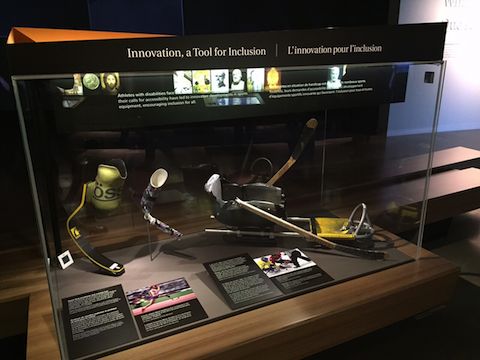Year of Sport
“Sport has the power to change the world.” – Nelson Mandela
The Olympic gold medal of Canadian swimming legend Mark Tewksbury. A running “tutu” worn by the first woman to register in the Boston Marathon. A hockey sledge for athletes with disabilities. These are a few of the artifacts included in an exhibition that marks the Year of Sport in Canada (2015). Read the news release.

Located in the Museum’s introductory gallery (What Are Human Rights?), this exhibition is arranged around three themes:
1/ Athletes breaking barriers of discrimination.

It takes courage to confront discrimination and break barriers. Many athletes have overcome personal challenges and, in the process, inspired others to fight for equality. This display includes the stories of:
- Olympian Mark Tewksbury, a pioneering force in advocating for the rights of athletes of all sexual orientations and gender identities
- American women’s rights champion Kathrine Switzer, who challenged the rules prohibiting women from running in the Boston Marathon.
- Herb Trawick, the first Black player recruited by the Montreal Alouettes of the Canadian Football League, in 1946.
2/ Organizations using sports to create change.

Recognizing the vital role sports can play to foster equality, conflict resolution, fairness and inclusion, many organizations use sport programs to advance human rights around the world. This display includes:
- A bicycle helmet and jersey from Mountain2Mountain, a group working in Afghanistan to promote women’s rights and acceptance of their cycling.
- A t-shirt and soccer ball from Coaches Across Continents, which uses soccer and coach training to help improve quality of life for children in countries around the world.
3/ Innovation for inclusion.

Athletes with disabilities have been active in identifying solutions for sports equipment that can remove barriers to participation. This display includes:
- A hockey sledge that enables wheelchair athletes to play Canada’s most popular sport.
- An upper-limb prosthesis and a running blade, used to enable athletes with disabilities to participate in hockey and in track events.












